In the quiet town of Serebryansk, students from School No. 1, named after M.V. Inyushin, are doing something extraordinary: growing exotic fruits like pineapples, pitaya (dragon fruit), and chocolate figs in their school greenhouse. This initiative combines science education with sustainable farming practices, fostering both curiosity and innovation.
Cultivating Exotic Fruits
Currently, the school’s greenhouse hosts 11 pineapples, with students eagerly tending to their growth. As director Irina Beschalova noted, the first figs from newly gifted chocolate fig saplings have already fallen, a natural process before the plants begin producing edible fruit. The school celebrates its agricultural achievements with an annual “Pineapple Festival,” where these homegrown fruits are shared with first-grade students.
Beyond Exotic Fruits
In addition to tropical produce, the greenhouse serves the school’s kitchen by supplying fresh herbs like dill and parsley. These practical applications connect students’ efforts directly to their community, emphasizing the importance of locally grown food.
The greenhouse also functions as a laboratory for biology lessons, allowing students to experiment with new plants and learn about the science behind growth. During the summer, students expand their agricultural activities to a school vegetable garden and a rose garden, which enriches their understanding of seasonal horticulture.
Educational Benefits
Participating in greenhouse cultivation develops students’ patience and responsibility. The hands-on experience encourages research skills, as students analyze plant growth and learn to adapt to challenges. One standout project involves integrating IT into agriculture, as the school works on an advanced irrigation system to optimize greenhouse management.
Global and Local Implications
This initiative mirrors broader trends in agricultural education worldwide. School gardens and greenhouses are increasingly recognized for their role in teaching sustainability, biology, and innovation. According to recent studies, such programs improve not only students’ knowledge but also their attitudes toward the environment and food systems.
The greenhouse project at School No. 1 in Serebryansk is a shining example of how education can bridge science, sustainability, and community engagement. By growing exotic fruits and developing innovative agricultural solutions, students are acquiring valuable skills that will benefit both their local community and the broader agricultural sector.










